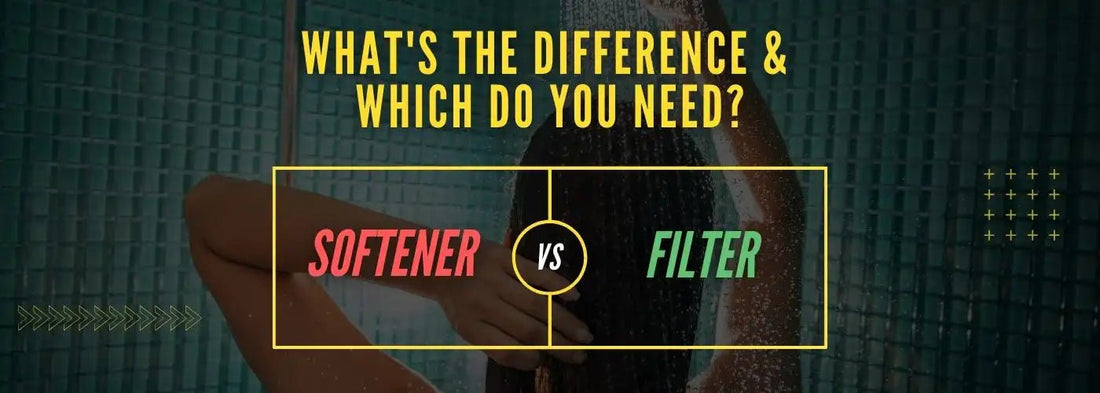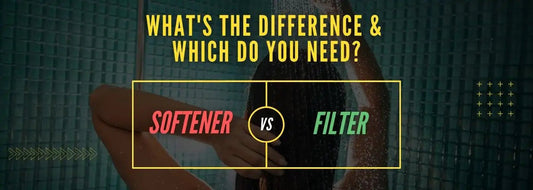
Water Softener vs. Water Filter: What's the Difference & Which Do You Need?
Share
Solving Your Home's Water Woes: Softener or Filter?
Is your water causing problems in your home? Maybe you're seeing chalky white scale buildup on faucets and showerheads. Perhaps your water has an unpleasant taste or smell, like chlorine from the municipal supply. Or maybe you're dealing with multiple contaminants at once!
When researching solutions, you'll often encounter two main types of whole-house water treatment systems: water softeners and water filters. While both improve your water quality, they tackle fundamentally different problems. Understanding this difference is crucial to choosing the right system for your home. Let's break it down.
What Problem Does a Water Softener Solve? (Hardness & Scale)
Water softeners are designed specifically to combat hard water. Hard water contains high levels of dissolved minerals, primarily calcium and magnesium. While not typically harmful to health, these minerals are the culprits behind frustrating household issues.
The Trouble with Hard Water Minerals
- Scale Buildup: This is the most common sign. Hardness minerals form crusty, white deposits inside pipes, water heaters, dishwashers, coffee makers, and on fixtures. This scale buildup reduces appliance lifespan, increases energy costs (especially for water heaters by insulating the heating element), and can eventually clog plumbing.
- Soap Scum & Cleaning Issues: Hard minerals interfere with soap, preventing a good lather and leaving residue on skin, hair, dishes, and laundry.
- Stiff Laundry & Spotty Dishes: Clothes washed in hard water can feel rough, and glassware often comes out covered in spots or film.

How Softeners Combat Hardness
Water softeners primarily use one of two methods:
- Ion Exchange: Traditional salt-based softeners use a resin bed to physically remove calcium and magnesium ions, swapping them for sodium ions. This is the classic ion exchange process.
- Salt-Free Conditioning (TAC/SAC): Systems like RKIN's Onlisoft use Template Assisted Crystallization (TAC) or Seed Assisted Crystallization (SAC) to change the structure of hardness minerals so they can't form scale, without using salt or removing the minerals entirely.
Bottom Line: A water softener or conditioner specifically targets hard water minerals to prevent damaging scale buildup and improve soap efficiency. They do not typically remove other contaminants. See our comparison article on water softeners vs. water conditioners.
What Problem Does a Water Filter Solve? (Contaminants, Taste & Odor)
Water filters, specifically whole-house water filters (also called Point-of-Entry systems), are designed to remove a wide array of contaminants from all the water entering your home, improving its taste, smell, safety, and clarity.
Common Contaminants Targeted by Filters
The specific contaminants removed depend heavily on the filter type and media used. Common targets include:
- Disinfectants: Chlorine and chloramine, widely used by municipalities, causing unpleasant tastes and odors. Quality carbon filters are effective here.
- Sediment: Physical particles like dirt, sand, rust, and silt that make water cloudy and can clog appliances.
- Chemicals & VOCs: Pesticides, herbicides, industrial solvents, disinfection byproducts like Trihalomethanes (THMs) and Haloacetic acids (HAAs), volatile organic compounds (VOCs), and fuel additives like MTBE. Activated carbon is a key player in adsorbing many of these.
- Emerging Contaminants: Concerns are growing about PFAS (forever chemicals). While standard whole-house carbon filters may offer some reduction of certain PFAS, specialized filters are typically recommended for high levels or targeted removal. For instance, systems certified for specific reductions, such as advanced filters targeting lead and cysts (like the RKIN OP1L system), represent more targeted filtration options beyond basic chlorine or sediment removal.
- Well Water Issues: Specific filters address iron, manganese (staining), sulfur (odor), and high levels of sediment.

How Water Filters Work
Different water filter types utilize various methods:
- Adsorption: Media like activated carbon traps contaminants such as chlorine and VOCs on its vast surface area.
- Mechanical Filtration: Physically blocks particles larger than the filter's pore size (e.g., sediment filters).
- Oxidation/Reduction (Redox): Media like KDF can convert chlorine into harmless chloride ions and help reduce some heavy metals.
- (Other Methods): Technologies like Reverse Osmosis (typically point-of-use) or UV sterilization (for bacteria/viruses) address other specific issues not usually covered by standard whole-house filters.

Bottom Line: A whole house water filter targets specific contaminants to improve overall water quality (taste, odor, clarity, safety), but does not typically remove hard water minerals or prevent scale buildup.
Water Softener vs. Water Filter: Key Differences Summarized
| Feature | Water Softener / Conditioner | Whole House Water Filter |
|---|---|---|
| Primary Target | Hard Water Minerals (Calcium, Magnesium) | Contaminants (Chlorine, Sediment, Chemicals, PFAS*) |
| Main Goal | Prevent Scale Buildup, Improve Soap Lather | Improve Taste, Odor, Clarity; Remove Contaminants |
| Mechanism | Ion Exchange (Salt) or Conditioning (Salt-Free) | Filtration, Adsorption, Oxidation (Media-based) |
| Prevents Scale? | Yes | No |
| Removes Chlorine? | No | Yes (with Carbon/KDF media) |
| Reduces PFAS? | No | Potentially* (Specialized/Certified Filters Needed) |
| Improves Taste? | Not directly (unless hardness causes taste) | Yes (by removing chlorine, chemicals, etc.) |
Do You Need Both a Softener and a Filter?
For comprehensive water treatment in many homes, the answer is often yes. They address different issues:
- A softener won't fix your chlorine taste problem.
- A filter won't stop scale from damaging your water heater.
Using both provides multiple lines of defense. Often, a filter system (like Carbon + KDF) is installed alongside a water softener or conditioner. A sediment pre-filter is almost always recommended with either system. RKIN offers integrated whole house water treatment systems designed to tackle both hard water and common contaminants effectively.

How to Choose: Identify Your Water Problems
Making the right choice starts with understanding your specific water.
Step 1: Test Your Water!
This is non-negotiable, especially if you are on a private well water supply where water quality can vary significantly and isn't municipally treated. You can't solve a problem you don't understand. Getting a comprehensive water test will reveal your hardness level and identify specific contaminants like chlorine (if applicable), iron, sediment, lead, nitrates, bacteria, and potentially even PFAS. Options range from basic DIY strips to more detailed mail-in lab kits or using a local certified water testing laboratory.
If you are on municipal supply, municipalities usually provide an annual water quality report containing all the testing data.

Step 2: Match Solution to Problem
- Primary Issue: Scale Buildup (Hard Water): A water softener or salt-free conditioner is your priority.
- Primary Issue: Bad Taste/Odor (Chlorine, etc.), Cloudiness (Sediment): A whole house water filter is needed. Choose media based on test results (e.g., carbon for chlorine).
- Both Hard Water AND Contaminant Issues: A combination system or installing both a softener/conditioner and appropriate filters is the best approach.
- Well Water with Multiple Problems (Iron, Sulfur, Sediment, Hardness): Look for specialized well water treatment systems designed to handle these complex combinations identified by your water test.
Conclusion: The Right Treatment for Cleaner, Better Water
Don't let confusion between water softeners and water filters prevent you from getting the water quality you deserve. Remember their distinct roles: softeners fight hard water scale, while filters tackle contaminants.
The key is to test your water to understand its unique challenges. Armed with that knowledge, you can confidently choose the right system – whether it's a softener, a filter, or a comprehensive solution combining both – to protect your home and family.
Explore RKIN Whole House Water Treatment Systems to find high-quality softeners, filters, and combination units designed to address a wide range of water quality issues effectively.
Frequently Asked Questions (FAQ)
Q1: Does a water filter also soften water?
A: Generally, no. Standard whole-house filters like sediment, carbon, or KDF filters are designed to remove contaminants, particulates, and chemicals, but they do not remove the dissolved minerals (calcium and magnesium) that cause hard water and scale buildup. You need a dedicated water softener or conditioner for hardness.
Q2: Does a water softener also filter water (remove chlorine, etc.)?
A: No. Water softeners (using ion exchange) and salt-free conditioners (using TAC/SAC) specifically target hardness minerals. They do not filter out contaminants like chlorine, chloramine, sediment, VOCs, PFAS, or bacteria. Filtration requires different technology.
Q3: Do I really need a whole-house water filter if I have municipal/city water?
A: Often, yes. While city water meets EPA's legal minimum standards, it can still contain disinfectants like chlorine or chloramine (affecting taste/smell), disinfection byproducts, sediment from aging pipes, or trace levels of other contaminants. A whole house filter provides an extra layer of protection and significantly improves the taste, odor, and overall quality of your tap water.
Q4: Can I use a water softener and a water filter together?
A: Absolutely! It's a very common and often recommended setup. They perform different, complementary functions. Many homeowners install both (or a combination unit) for comprehensive water treatment, tackling both scale buildup and contaminants. Often, a filter is placed before a salt-based softener to protect the softener resin.
Q5: What kind of filter is best for removing chlorine taste and smell?
A: Activated carbon filters are highly effective at removing chlorine taste and odor through adsorption. Catalytic carbon is often used if your municipality uses chloramine (a mix of chlorine and ammonia). KDF media can also assist in chlorine removal. Look for whole house filters featuring high-quality carbon block or granular activated carbon (GAC).
Q6: How often do water filter cartridges need replacing compared to water softener maintenance?
A: Maintenance varies. Salt-based softeners need salt refilled regularly (e.g., monthly/bi-monthly). Salt-free conditioners require very little maintenance, maybe just a pre-filter change. Water filter replacement depends on the type: sediment pre-filters might last 3-12 months, while large whole-house carbon filter tanks might last several years, depending on water usage and contaminant levels. Always follow manufacturer guidelines (like RKIN's) for specific models.
Q7: What's the best way to know what's really in my water?
A: The most reliable way is to get your water tested, especially if you are on well water. Options include using a state-certified laboratory or a comprehensive mail-in water test kit (like those available from RKIN). While DIY test strips offer basic insights (like hardness or chlorine), they aren't as accurate or detailed as lab tests for identifying specific contaminants like chemicals, heavy metals, or PFAS.



